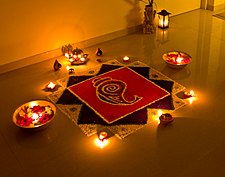"Deepavali" redirects here. For the 2007 film, see Deepavali (film).
| Deepavali | |
|---|---|
 Rangoli decorations, made using coloured powder, are popular during Diwali | |
| Also called | Translation: Row of Lights; Diwali, Festival of Lights, Deepawali |
| Observed by | Hindus, Jains, Buddhists, Sikhs,Arya Samajists |
| Type | Religious, India, Nepal, Sri Lanka, Myanmar, Mauritius,Guyana, Trinidad & Tobago,Surinam, Malaysia, Singapore, and Fiji (National holiday in these countries) |
| Date | Decided by the Hindu Lunisolar calendar |
| 2011 date | Wednesday, 26 October |
| 2012 date | Tuesday, 13 November |
| 2013 date | Sunday, 3 November |
| Celebrations | Decorating homes with lights and candles, Fireworks, distributing sweets and gifts |
| Observances | Prayers, Religious rituals (seepuja, prashad) |
Diwali (also spelled Devali in certain regions) or Deepavali,[note 1] popularly known as the "festival of lights," is a five day festival which starts onDhanteras, celebrated on thirteenth lunar day of Krishna paksha (dark fortnight) of the Hindu calendar month Ashwin and ends on Bhaubeej, celebrated on second lunar day of Shukla paksha (bright fortnight) of the Hindu calendar month Kartik. In the Gregorian calendar, Diwali falls between mid-October and mid-November. Diwali is an official holiday in India,[1] Nepal, Sri Lanka, Myanmar, Mauritius, Guyana, Trinidad & Tobago, Suriname,Malaysia, Singapore and Fiji.
For Hindus, Diwali is one of the most important festivals of the year and is celebrated in families by performing traditional activities together in their homes. For Jains, Diwali marks the attainment of moksha or nirvana by Mahavira in 527 BCE.[2][3] Arya Samajists, celebrate this day as Death Anniversary of Swami Dayanand Saraswati. They also celebrate this day as Shardiya Nav-Shasyeshti.
The name "Diwali" or "Divali" is a contraction of "Deepavali" (Sanskrit: दीपावली Dīpāvalī), which translates into "row of lamps".[4] Diwali involves the lighting of small clay lamps (dīpa in Sanskrit: दीप) filled with oil to signify the triumph of good over evil.[5] These lamps are kept on during the night and one's house is cleaned, both done in order to make the goddess Lakshmi feel welcome.[6] Firecrackers are burst because it is believed that it drives away evil spirits.[7][8][9] During Diwali, all the celebrants wear new clothes and share sweets and snacks with family members and friends.
The festival starts with Dhanteras on which most Indian business communities begin their financial year. The second day of the festival is called theNaraka Chaturdasi. Amavasya, the third day of Diwali, marks the worship of Lakshmi, the goddess of wealth. The fourth day of Diwali is known asKartika Shudda Padyami. The fifth day is referred to as Yama Dvitiya (also called Bhai Dooj), and on this day sisters invite their brothers to their homes.

No comments:
Post a Comment